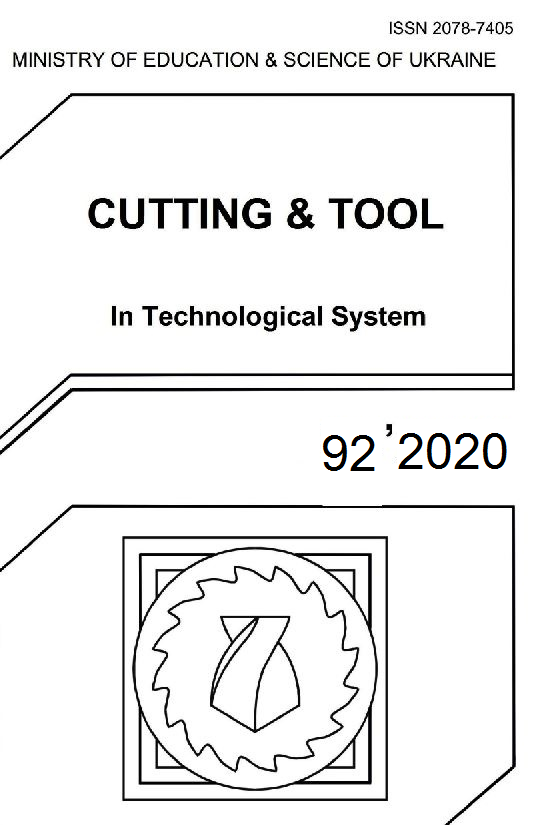HEAT EXCHANGE IN THE LIQUID COOLANT APPLICATION SYSTEM OF GRINDING MACHINES
DOI:
https://doi.org/10.20998/2078-7405.2020.92.16Keywords:
grinding machine, heat exchange, heat flow, temperature, liquid coolant application system, pressure, flow rate.Abstract
Thermal processes taking place in grinding machines have a great influence on the quality and accuracy of the surface being machined. A liquid coolant application system plays an important role in the formation of heat flows. Each element of that system has a certain effect on the temperature of the coolant and the grinding machine as a whole. This article discusses the structural diagram of heat transfer in the elements of the liquid coolant application system, which consists of a strainer, pipelines, check valve, pump, throttle, hydrocyclone, grinding dust tank of a hydrocyclone, safety valve, control valve, coolant supply device, cutting zone, bed, drain tray, magnetic separator, and coolant reservoir. It is noted that part of the flow energy when passing through an element of the system is converted into thermal energy and causes heating of the coolant, element, and the system as a whole. A technique for defining the heat balance in a coolant application system, taking into account its organizational, structural parameters, cutting conditions, as well as other factors of the grinding process is proposed. Mathematical dependencies for determining the quantity of heat released when liquid coolant passes through each element of the system, taking into account its hydraulic parameters are proposed. The elements of the liquid coolant application system that have the greatest influence on the coolant temperature are identified. A comparative analysis of the heat fluxes passing into the coolant during the passage of the pump was carried out for various grinding processes and the types of grinding machines that implement them. It has been found out that under processing conditions requiring the use of high flow rates and coolant pressures, the heat released in cleaners and other system elements should be taken into account, the operation of which is accompanied by significant pressure differentials. The possibility of monitoring and controlling the temperature of the coolant, based on the fact that the heat generated by the passage of coolant through a device operating under pressure, is also determined by the pressure differential across this device.References
Brecher C., Bäumler S., et al. Energy Efficient Cooling Systems for Machine Tools. Leveraging Technology for a Sustainable World. Proceedings of the 19th CIRP International Conference on Life Cycle Engineering. Berkeley, 2012, pp. 239-244. doi: 10.1007/978-3-642-29069-5_41.
Stepanov M., Ivanova M. et al. Study of Thermal Modes of Working Fluids in Grinding Machines. In: Tonkonogyi V. et al. (eds) Advanced Manufacturing Processes. InterPartner 2019. Lecture Notes in Mechanical Engineering. Springer, Cham, 2020, pp. 299-308. doi:10.1007/978-3-030-40724-7_31.
Polyakov A.N., Marusic K.V. Upravlenie termodeformaczionny`m sostoyaniem stanka na osnove avtomatizaczii prognozirovaniya temperaturny`kh peremeshhenij ispolnitel`ny`kh organov: uchebnoe posobie [Control of the thermodeformation state of the machine based on the automation of forecasting the temperature movements of executive bodies: a training manual]. Orenburg, Orenburg state university, Publ. OSU, 2012. 220 p.
Mayr J., Gebhardt M. et al. Cutting fluid influence on thermal behavior of 5-axis machine tools. Proceedings of the 6th CIRP International Conference on High Performance Cutting. Zurich, 2014. pp. 395 – 400. doi: 10.1016/j.procir.2014.03.085.
J. Weber, Jü. Weber et al. Energy, power and heat flow of the cooling and fluid systems in a cutting machine tool. Proceedings of the 17th CIRP Conference on High Performance Cutting, 46, 2016 pp. 99 – 102. doi: 10.1016/j.procir.2016.03.177.
Patil1 P. S., Mudholkar R. R. Cooling Techniques for a Spindle of Machine Tool. International Journal Of Engineering And Computer Science, 2016, Vol. 5, Issue 12, pp. 19653-19656. doi: 10.18535/ijecs/v5i12.70.
Abankin Yu. I. Opredelenie optimal`ny`kh razmerov sopla sistemy` podachi SOZH. [Determining the optimum nozzle size for the coolant supply system]. Smazochno-okhlazhdayushhie tekhnologicheskie sredstva v proczessakh abrazivnoj obrabotki. Sb. nauchn. Trudov [Lubricating and cooling technology in abrasive processes. The collection of scientific works]. Ulyanovsk, 1988, pp. 56-61.
Sizy`j Yu.A., Stepanov M.S. Teplovoj balans proczessa shlifovaniya [The heat balance of the grinding process]. Rezanie i instrument v tekhnologicheskikh sistemakh [Cutting & Tools in Technological System]. Kharkiv, Publ. NTU «KhPI`», 2000, pp. 177–190.
E.lyanov V.D., Kulikov V.N. Prizhogi pri shlifovanii [Burning when grinding]. Moscow, Publ. NIIMASH, 1974, 63 p.
Chugaev, R. R. Gidravlika : (Tekhnicheskaya mekhanika zhidkosti) : Uchebnik dlya vuzov [Hydraulics: (Technical fluid mechanics): Handbook for high schools], 2 edition, Leningrad, Publ. Energoizdat, 1982, 672 p.
Stepanov M. S., Litovchenko P. I., Ivanova L. P. Matematichna model` teploobminu u rezervuari MOR shlifuval`nogo verstatu [Mathematical model of heat exchange in the coolant tank of grinding machine]. Visnik Zhitomirs`kogo derzhavnogo tekhnologichnogo universitetu. Seriya : Tekhnichni nauki [Bulletin of the Zhytomyr State Technological University. Series: Technical Sciences], 2017, Vol. 2(1), pp. 90-96.
Downloads
Published
Issue
Section
License
Copyright Notice
Authors who publish with this Collection agree to the following terms:
1. Authors retain copyright and grant the Collection right of first publication with the work simultaneously licensed under a Creative Commons Attribution License that allows others to share the work with an acknowledgement of the work's authorship and initial publication in this Collection.
2. Authors are able to enter into separate, additional contractual arrangements for the non-exclusive distribution of the Collection's published version of the work (e.g., post it to an institutional repository or publish it in a book), with an acknowledgement of its initial publication in this Collection.
3. Authors are permitted and encouraged to post their work online (e.g., in institutional repositories or on their website) prior to and during the submission process, as it can lead to productive exchanges, as well as earlier and greater citation of published work.

